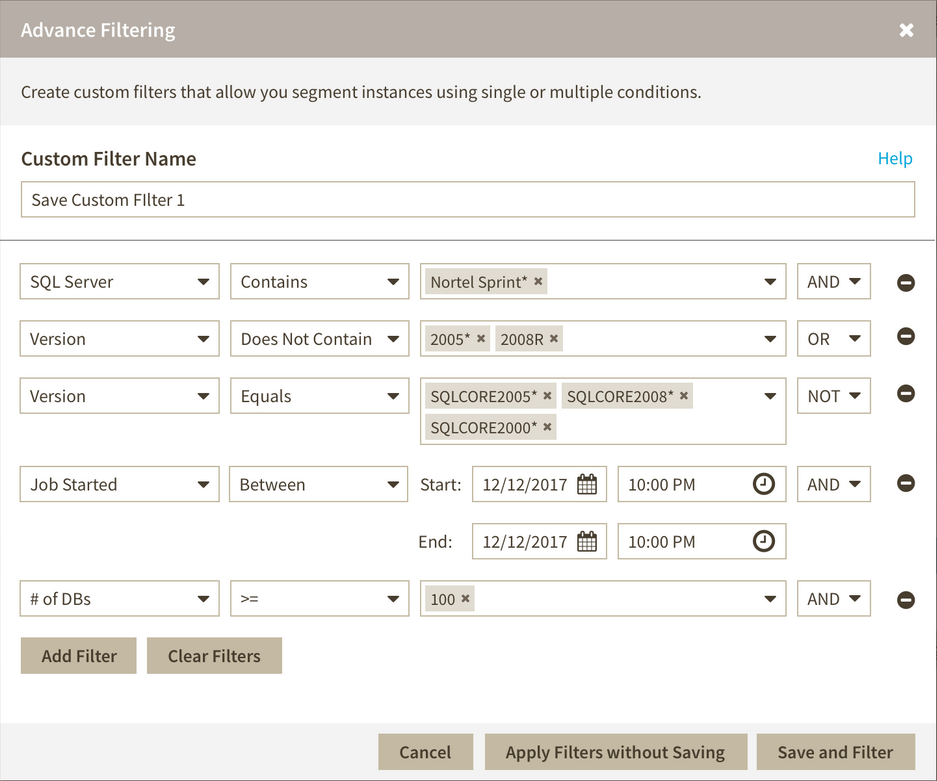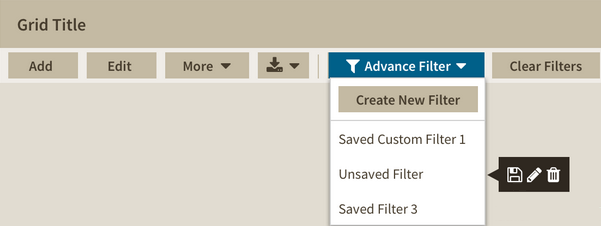Page History
The advanced filtering allows you to apply multiple filters using conditional statements such as AND, OR, or NOT, and operators like Does not contain, Contains, Equals, Does not equal.
The principal function of this filtering option is the Advanced Filter button.
Principal Menu
Add an advanced filter
The advanced filter
Edit advanced filters
More options
Export
Advance filter
Advance Filter
When you select When a user clicks onto the Advanced Filter Drop-Down Button, A button, a drop-down menu opens with Create Filter Button, a divider line and list of saved custom filters with edit and delete icons.
Next to the filter names there are edit and delete options
With the edit option a new Advance Filtering wizard displays, where you can edit all available parameters and save them.
After saving the filter a tag is placed above the grid with the assigned filter name. When a filter is applied without saving a "Unsaved Filter" tag is placed above the grid.
"Unsaved Filter" is added to the drop down menu.
Edit Filters
On the Advanced Filter drop down list, point any filter and the options to edit and delete the filter displays.
By selecting the Edit option the advanced filtering wizard displays, letting you edit, apply, and save the filter.
Delete filters
...
configured filters.
At the top of the Drop-Down list you have the option to Create New Filter, the button opens a new wizard:
On the Custom Filter Name define a name for the filter.
With the Add Filter button a row of parameters to define the filter is added:
- On the first field you can select:
- SQL Server
- Status
- Edition
- # of DBs
- Size (MB)
- Owner
- Location
- Clustered
- Discovery methods
- On the second field you have the options:
- Contains
- Between
- After
- Before
- >=
- <=
- Equals
- The third field is variable according the first and second field, the possible options are:
- List of instances
- Instances status (UP, DOWN).
- Edition (PRO, ULTIMATE, Enterprise)
- Number of databases (10, 20, 30)
- Size (MB) (100 MB, 200 MB, 600 MB)
- Owner (Product Manager, Developer)
- Location (CA, Austin)
- Clustered (No, Yes)
- Discovery methods (Browser, Service, Service 1)
- Range of date and time
- The last field has the thee condicional as options:
- AND
- OR
- NOT
You can add as many rows as you require in your filter.
After configuring you filter you can Apply Filters without Saving and the filter will be available in the principal drop-down list with an Unsaved Filter name.
Or Save and Filter and the filter will be saved with the name you assigned to it, after saving a tag will be placed above the grid.
Pointing to the filter name, the edit and delete options will display. The Save option will only be available for Unsaved filters.
The Edit opens the advanced filtering wizard again, you can change parameters and Apply or Save your filter.
The Delete option deletes the filter permanently.
Export Filter
You can export the filtered results in three different formats:
- Excel
- CSV
- HTML
Clear Filters
When there are no filters applied this button is disabled.
...



